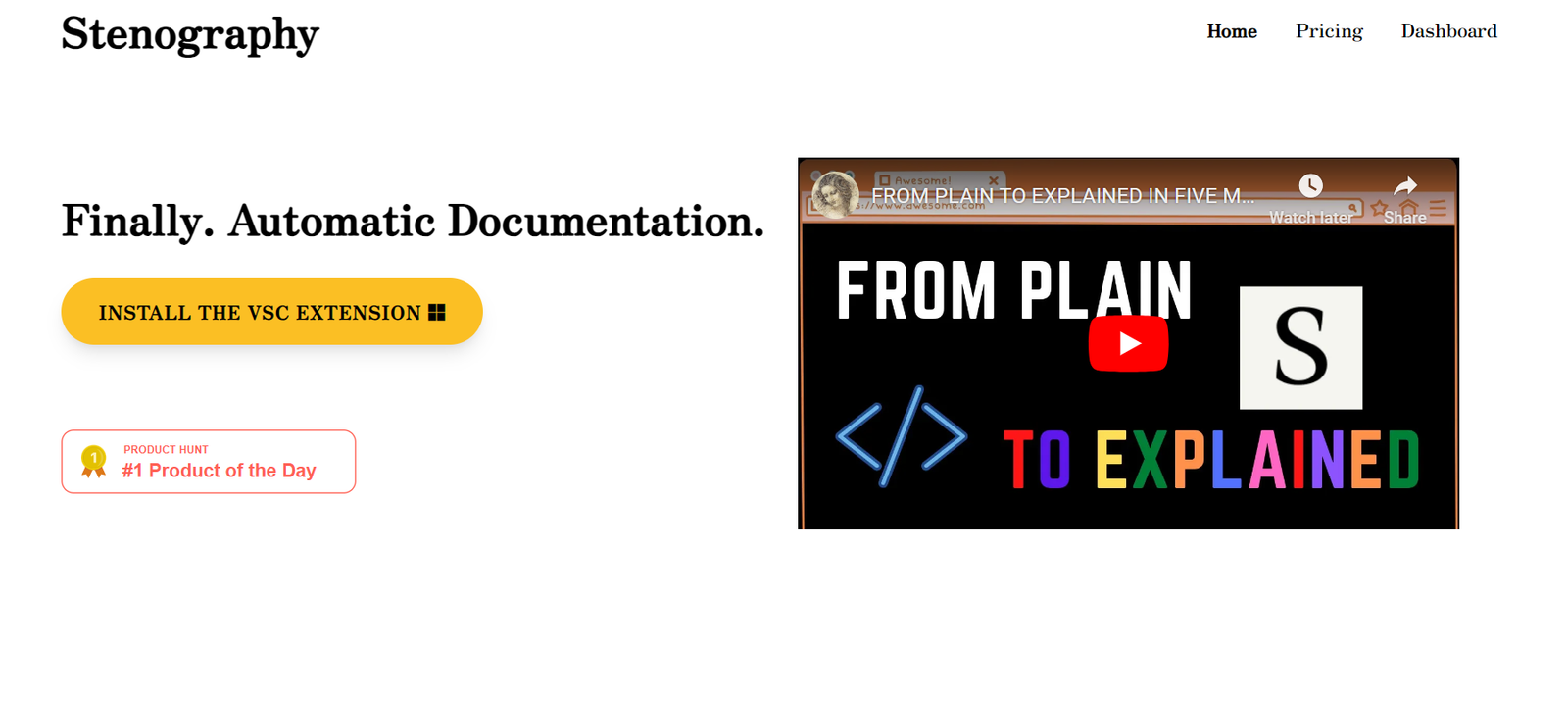Code documentation is a critical yet often neglected aspect of software development. However, manually updating documentation across rapidly evolving codebases can be tedious and time-consuming.
This is where Stenography AI comes into the picture – an innovative AI-powered tool designed specifically to revolutionize code documentation processes.
In this extensive Stenography AI review, we dive into all its capabilities, pricing plans, pros and cons, top alternatives, and more to help you determine if it’s the right fit for your needs.
What is Stenography AI?
Stenography AI is an automatic code documentation tool crafted to simplify and streamline the documentation process for developers. It utilizes advanced artificial intelligence to automatically generate and update documentation every time changes are made to the codebase.
The tool was created by Bram Adams – an OpenAI Developer Ambassador and GPT-3 O’Reilly Media instructor. By integrating GPT-3 capabilities, Stenography AI can parse code context and produce relevant documentation without any human involvement.
Overall, Stenography AI aims to enhance developer productivity by eliminating tedious documentation tasks.
How Stenography AI Works
The core functionality of Stenography AI relies on state-of-the-art machine learning techniques to offer an automated documentation experience.
Here’s a quick rundown of how it works:
- Developers connect their code editor to Stenography AI.
- The tool indexes and monitors the entire codebase.
- Whenever code changes are saved, Stenography AI automatically invokes its AI engine.
- The AI reviews code diffs, understands context, and updates documentation across the codebase.
- Developers can customize output specs and even generate explanations for specific code snippets.
This hands-free process ensures code documentation remains up-to-date without any time investment from developers.
Also Read: OutFits AI Review 2024
Features of Stenography AI
Stenography AI is packed with user-centric features designed for optimal convenience. Let’s explore them in detail:
Autopilot Documentation
The crown jewel of Stenography AI’s capabilities is its autonomous documentation functionality. The tool continuously tracks code changes and updates accompanying markdowns automatically in real-time while developers code. This keeps the entire codebase effortlessly documented.
Powerful API
Alongside auto-documentation, Stenography AI incorporates a robust API allowing users to pass in code snippets and receive back explanations in plain English. The explanations provide clarity into complex segments and can be customized to developers’ specific requirements.
Stack Overflow Integration
To eliminate dependency on external platforms, Stenography AI directly suggests relevant Stack Overflow documentation and solutions related to developers’ codebases. This handy embedded integration avoids context-switching and enhances productivity.
Extensions Compatibility
Stenography AI is designed to integrate seamlessly across various platforms including popular code editors like VS Code and IDEs like PyCharm. This ubiquitous compatibility ensures a streamlined documentation experience regardless of coding environment.
Privacy First Approach
When it comes to AI tools, privacy is often a top concern. Stenography AI eases such concerns by utilizing a passthrough API system to keep users’ source code securely on their machines rather than Stenography’s servers.
How much does Stenography AI cost?
Stenography AI offers flexible pricing plans to meet diverse budgetary needs. Here is an overview:
| Plan | Price |
|---|---|
| Free | $0 per month |
| Pro | $19 per month |
| Business | $49 per month |
The Free plan offers limited functionality for individual developers. Pro unlocks more features for small teams, while Business caters to larger enterprises. Contact Stenography AI for detailed custom quotes.
Pros of Stenography AI
| Pros |
|---|
| Automates time-consuming documentation tasks |
| Enhances team coordination and alignment |
| Allows customization of output |
| Easy integration across tools/platforms |
| Secures source code privacy |
Cons of Stenography AI
| Cons |
|---|
| Steep learning curve for the powerful API |
| Lacks offline functionality |
| Determining optimal customization requires experimentation |
| Free plan has limited capabilities |
How to Use Stenography AI: Complete Overview
Using Stenography AI involves just a few simple steps:
Step 1: Create an account and configure your code editor to connect with Stenography AI.
Step 2: Index your code repositories to allow the tool to scan and analyze your codebase.
Step 3: Customize auto-generated documentation settings and API explanations as needed.
Step 4: Code as usual while Stenography AI handles documentation in the background.
Step 5: Review auto-updated docs and manually refine further if required.
That’s all – Stenography AI eliminates documentation bottlenecks for streamlined development.
Stenography AI Alternatives
| Alternative | Pros | Cons |
|---|---|---|
| Documancer | Powerful integrations <br> Feature-rich | Costly <br> Steep learning curve |
| CodeDocs | Intuitive UI <br>Great onboarding | Limited language support |
| Docmate | Open-source <br> Customizable | Inconsistent performance |
| CodeStory | Template variety <br> Team-oriented | Rigid workflows |
| Autodoc | Easy setup <br> Lightweight | Basic capabilities |
Conclusion and Verdict: Stenography AI Review
In closing, Stenography AI introduces game-changing AI-powered capabilities to simplify code documentation – a task notorious for impeding developer velocity. Its autonomous approach keeps entire projects effortlessly documented in virtually no time.
For developers struggling with documentation debt and cluttered markdowns, Stenography AI brings in a hands-free solution to eliminate major bottlenecks. While still relatively new, it sets the stage for the future of AI-assisted development tools.
Overall, Stenography AI delivers immense value, especially for dynamic teams collaborating on rapid development cycles. Its capabilities outweigh limitations, making it a recommendable toolkit for most use-cases.
FAQs: Stenography AI
What programming languages are compatible?
Stenography AI is compatible with most major languages including Python, JavaScript, Java, Ruby, C++, and more.
Is Stenography AI GDPR compliant?
Yes, Stenography AI is GDPR compliant given its privacy-first approach and avoidance of storing user source code.
Can Stenography AI explain code logic?
Yes, through its powerful API developers can input snippets and receive back detailed explanations demystifying code logic.
Does Stenography AI work with version control?
Absolutely! It integrates directly with systems like Git, automatically documenting code diffs commits.
Can multiple developers collaborate?
Stenography AI facilitates seamless collaboration, maintaining consistent up-to-date documentation readable across entire teams.

